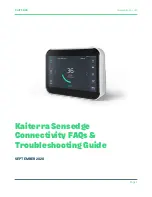
Page 8
SRP-003-545 • Issue 4 • July 2004
Plunger
Housing
Fingers
Pull the plunger fastener
out all the way so that
the fingers collapse.
Position the fastener into
the mounting holes in
the housing.
Push the plunger in to
expand the fingers and
lock the unit to the housing.
To remove the unit, pull the plungers out.
CAUTION:
The connector is a delicate device.
Obey the following precautions. Damage to the
surface of the connector will make it unusable:
•
Use a clean tissue soaked in alcohol to
gently clean the connector. Do not press
heavily on it as you clean.
•
Dry the connector prior to installation with
compressed air or a dry tissue.
•
Clean all areas that will contact the
connector adapter.
•
Do not force the connector into the
receptacle. If the connector does not fit
easily into the receptacle, back it out and
reinstall.
•
Install threaded connectors into the adapter
and tighten. Do not OVERTIGHTEN. Do
not allow the connector body (ferrule) to
turn as you screw it into place. This causes
the surfaces to grind against each other.
10.5
Remove the blank connector panels from
the unit (Figure 15). Install the loaded
connector panels into the connector support
bracket (Figure 16).
10.6
Repeat for all required panels.
Figure 15
11. Splicing
11.1
The unterminated ends of pigtails are
spliced to buffered fibers in a splice tray
(Figure 14). Prepare the buffer tubes for
splicing.
a) Route three complete loops of fiber around
the radius guides in a counterclockwise
direction. The radius guides are divided into
three sections. Begin routing from the back
section and work your way forward with
each loop in a different section of the guide.
b) Reinstall the splice tray holder and install
one of the splice trays you will be using.
c) Place
ALL
the buffer tubes as they will lie
after installation and mark the cable 2 cm
(
3
/
4
inch) from where it will enter the corner
of the splice tray as shown in Figure 17.
(This is where the buffer tube will be
removed.)
d) Refer to the instructions provided with the
splice tray to determine the appropriate
length of fiber required in the tray. Measure
from the first mark toward the end of the
buffer tubes and mark the buffer tubes.
e) Trim the excess buffer tube beyond the
second mark.
f) Remove the splice tray and the coiled buffer
tubes.
g) Remove the buffer tubes to the marked
point (plus the length needed inside the
tray). Strip and clean the fibers according to
the cable manufacturer’s instructions.
Figure 16
Figure 17

























